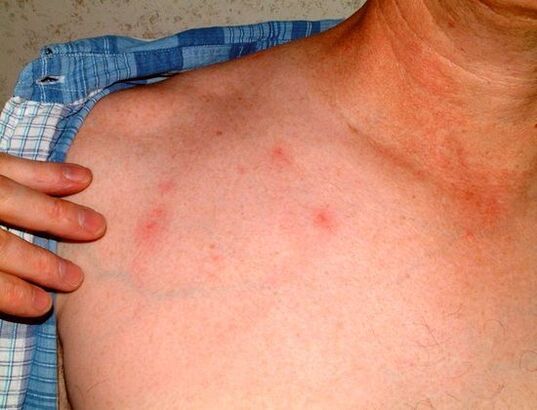
How much do you know about human parasitic diseases? The types of human parasites are not limited to internal worms.
Certain types of parasites penetrate and live under the skin of a person, causing the same unpleasant symptoms as internal parasites.
In addition, diversity is not limited to helminthiasis-there are also ticks, insects, and protozoa.
Each of them has certain symptoms and manifestations that you should be aware of.
Knowing how to remove parasites under the skin is also important.
Types of parasitic skin diseases
What kind of parasites can live under human skin? The most diverse are insects, worms, ticks, and protozoan single-celled organisms. Human skin damage caused by various types of parasites is divided into separate parasitic diseases.
Each group of diseases is combined by characteristic pathogens:
- The simplest organisms can cause protozoan skin diseases.
- Ticks can cause skin mites.
- Insects can cause insect skin lesions.
- Helminthiasis is caused by worm infection.

All these pathogens of human skin parasitic diseases are equally unpleasant and require diagnosis and treatment. Forms that have been neglected for a long time can lead to irreversible consequences ranging from blindness to death. Fortunately, it can be added that the list of most parasites living under human skin is mainly for countries with hot and humid climates.
Diseases caused by protozoa
Leishmaniasis
Leishmaniasis is caused by the simplest single-cell pathogen carried by mosquitoes. People infected with leishmaniasis become reservoirs for the further spread of the infection. After being bitten by a mosquito (the main host of Leishmania), a person develops skin or visceral leishmaniasis. Cutaneous leishmaniasis manifests as deep ulcers or pustules and extensive skin lesions. The skin and mucous membrane form of the disease causes a significant deformation of the appearance, especially on the face. Airway edema in Leishmaniasis can be fatal.
Leishmaniasis occurs in 90 countries in the world. It is a very common disease in Syria, Iran, Afghanistan, Saudi Arabia, Brazil, and Peru.
Diseases caused by ticks
Demodex
A disease caused by parasites that live in the sebaceous glands and human hair follicles. This is a tiny mite-Demodex. It is mainly located on the eyelids, facial skin and ear canal. Rarely-on the chest and back.
Demodex damage causes complex acne and dermatitis, which is aggravated in spring and autumn. The skin looks red, bloodshot, bumpy, and inflamed. The edges of the cilia of the eyelids are usually swollen and red, the eyelashes are stuck together, and there are scab-like secretions along the edges of the eyelids, which are characterized by the loss of eyelashes. Sometimes the disease has no obvious manifestations, so ticks are considered conditionally pathogenic. Generally, Demodex is exacerbated in people with impaired immunity, gastrointestinal diseases, lung diseases, and metabolic disorders.
scabies
Another common disease caused by mites is called itching. These mites gnaw on the channels of human skin and lay their eggs in them. The development of adult ticks is accompanied by a complex cycle. Usually this process occurs at night, so the itching of the skin will increase at this time. The main diagnostic symptom of the presence of parasites under human skin looks like double red dots located nearby. These are dual channels that have been bitten by ticks.

The disease is complicated by the various infections that patients try to relieve itching: streptococci, nodular seals, blood scabs around scratches, rashes in the form of blood blisters, and other skin lesions. Complex scabies may resemble urticaria, pyoderma, dermatitis, eczema, and psoriasis.
Infection usually occurs through prolonged contact with the patient (it has been shown that scabies requires skin-to-skin contact for up to 30 minutes; when using ordinary household items, the probability of infection should not be relatively low).
Diseases caused by insects
All skin diseases caused by dipteran insects are collectively referred to as myiasis.
Lupus
This disease is caused by an insect called wolfarth fly, which places the larvae in the mucous membranes or wounds of the human body. The larvae destroy tissues and release a special enzyme, causing severe pain, necrosis, edema, pus, and gangrene in the affected tissues. They usually live in the eyes, nose, and ears. Wolfarth flies are common in countries with hot and temperate climates.
Diseases caused by worms
Heartworm disease
A disease caused by round worms. The source of infection is domestic animals-cats and dogs. The carrier is a mosquito. After being bitten, sexually mature nematode individuals begin to develop in the human body, usually parasitizing under the human skin. Insect bites become denser, inflamed and itchy. A characteristic of the pathogen is its ability to move under the skin. Therefore, this disease is accompanied by a sensation of movement, crawling inside the inflamed seal. Nematodes can sometimes be seen under the skin; describes the condition of individuals emerging from the mucous membrane of the eye.
Allergic reactions, fever, nausea, and weakness may accompany symptoms.
Strongyloidosis
A disease caused by parasite larvae, when he walks barefoot on the ground, it invades a person's skin. Strongyloides lesions were found in Georgia, Ukraine, Krasnodar, and Stavropol Krai. Roundworm larvae invade through the skin and migrate underneath, causing skin redness, itching, and red blisters.
Treatment recommendations
General recommendations have been formulated for the treatment of diseases caused by one or another human subcutaneous parasites. The most relevant to our region is the treatment of strongyloidiasis, scabies and demodicosis. Treatment is prescribed after the diagnosis of the disease and can only be performed by a specialist. Some complications and manifestations of the disease require individualized treatment.
- It is recommended to use antiparasitic drugs to treat helminthiasis.
- For the treatment of itching, use ointments, creams and other effective remedies. In the prevention and treatment of scabies, a treatment plan and a system of contact prevention measures have been formulated.
- Demodex treatment is carried out through complex measures to strengthen the immune system, treat gastrointestinal diseases and other procedures. The ointment used to treat scabies is directly applied to the skin, as well as various cosmetic procedures.

Subcutaneous parasitic diseases require hard work, so it is best to prevent infection by applying basic personal hygiene rules. It is not superfluous to understand the common symptoms accompanying such diseases so as to avoid close contact with the patient.




























